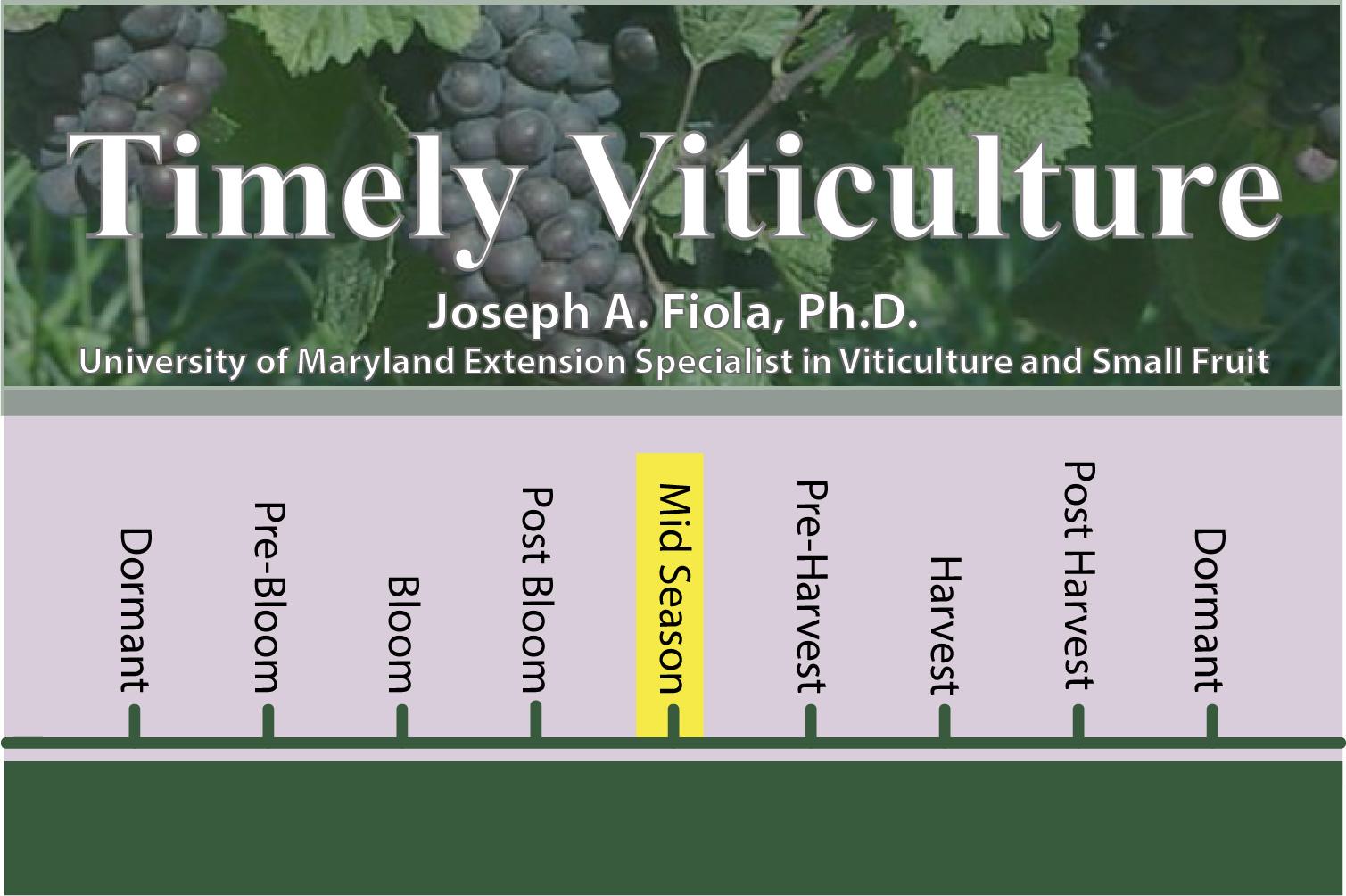Mid-Season Disease Management
At 3 to 4 weeks post-bloom, the risks of black rot (BR), Phomopsis (Ph; including cane and leaf spot, and fruit rot), and powdery mildew (PM), and downy mildew (DM) on fruit clusters are decreasing. During the middle season in Maryland, DM on foliage may draw the most attention. Additionally, spraying for Botrytis may be needed at bunch closure and veraison if the disease has been a concern in the past and cool/damp conditions are expected during these two stages.
First Cover Spray (10–14 days after post-bloom spray)
- Apply the first cover spray near the end of the critical period for controlling fruit infection by BR, PM, and DM (immediate pre-bloom through 4 weeks after bloom). Ph is a diminishing threat in most vineyards because the fungus becomes inactive in hot weather. Grape berries become resistant to BR, PM, and DM 4 weeks post-bloom.
- If the weather has been unusually wet or Ph has been a problem in your vineyard, use mancozeb (note PHI) or captan in this spray. Both fungicides also offer good protection against DM, with mancozeb being more effective for BR control. DMIs (FRAC 3) except for triflumizole, which is found in products like Trionic, Procure, and Viticure, and QoIs (FRAC 11) are excellent fungicides for BR. Phosphorous acid products are effective for DM control, and should be used just before or just after an DM infection period.
- Scout for PM infections on leaves, berries, and rachises. If you see actively sporulating colonies, consider roguing the infected tissues if possible, followed by fungicide sprays. Note that risk of resistance to DMIs (FRAC 3) and QoIs (FRAC 11) is high. Resistance to Quintec has also been detected in the region, although the frequency is low. SDHI materials (FRAC 7), Vivando, Torino and Gatten (a new material) should be more reliable at this point.
Second Cover Spray (10–14 days after the 1st cover spray)
- Scout for PM and DM. If there are no active colonies, continue protectant sprays. While fruit are becoming resistant to infection, shoots, leaves, rachises remain susceptible until the end of the growing season.
- For active PM colonies, see the notes under the 1st cover spray. For severe PM, consider applying a single “rescue” spray of stylet oil.
- Keep in mind that oil sprays at this stage may delay fruit ripening. Do not apply oil within 14 days of sulfur or captan to avoid vine injury.
- Keep in mind that oil sprays at this stage may delay fruit ripening. Do not apply oil within 14 days of sulfur or captan to avoid vine injury.
- Studies have shown that berries of Vitis vinifera acquire ontogenic resistance to PM rapidly after fruit set.
- It is notable that diffuse and non-sporulating PM colonization can occur on young berries during 3 to 4 weeks after bloom, when berries are undergoing the transition from a moderate to a high level of resistance to PM. This non-sporulating infection is difficult to see with the naked eye and can provide entry points for opportunistic fungal pathogens and insects, leading to bunch rots later in the season. Thus, it is important to maintain a good fungicide protection for PM until 4 weeks post bloom.
- For early and sporadic DM (“oil spots” on a few leaves), apply protectants such as captan or ziram.
- For sporulating DM, apply a phosphite or Ridomil Gold.
- Ridomil is very prone to resistance development, and shall only be considered as rescue treatment under severe DM infection with massive active spores. Limit: one Ridomil application per season.
- Although phosphites do not have eradicative activity (as does Ridomil), they do have excellent kick-back or post-infection activity, which will largely inhibit spore production and limit disease spread. Unfortunately, captan or ziram will only protect healthy tissue from DM but lacks post-infection activity.
- Except for protectant fungicides such as captan, mancozeb, sulfur, and ziram, trying to limit each FRAC code to no more than 2 times of spraying per season for fungicide resistance management.
Additional Cover Sprays (at 10–14-day intervals)
- Continue to scout for DM and PM. Adjust your spray program for the weather, diseases observed, varieties grown, and the expected harvest date.
- Maintain a good protection for PM diffuse infection (see the notes under the 2nd cover spray).
- At bunch closing and veraison, include a fungicide for Botrytis control under wet and cool weather conditions, especially on bunch rot-prone (tight-clustered) varieties.
- Watch for fruit rots, especially if there has been hail, bird damage, insect feeding, or PM on fruit.
As always, read the fungicide label for allowable rates, REIs, cautions and restrictions on use, and resistance management requirements. As we get to mid-season, remember to note and closely follow PHIs (Pre-harvest interval) for each fungicide. Remember, the label is the law.
Additional resources for grape disease management
- Virginia Tech Grape Pest Management: Grapes: Diseases and Insects in Vineyards (pdf)
- Penn State Grape Pest Management: Fungicide resistance management-webinar review
- Vine-Smith Spray Guides
For more information, contact Dr. Mengjun Hu at mjhu@umd.edu or Dr. Joseph A. Fiola at jfiola@umd.edu.
Timely Viticulture is designed to give those in the Maryland grape industry a timely reminder on procedures or topics they should be considering in the vineyard.
